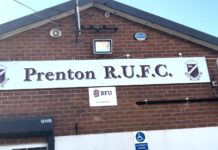While the people of Liverpool were congratulating themselves when Woolton was announced as one of 2025’s best places to live by The Sunday Times, they might have missed the fact that another place on the list is also on their doorstep. Parbold, a sleepy village on the Liverpool-Leeds Canal, was vital to Liverpool’s industrial port and has since been transformed by world events, its surrounding cities and the people who call it home.
If I were to ask someone who is not from the local area to point out where Parbold is on a map, it would not be surprising if they struggled to point to the correct county. It was surprising, therefore, to find this quiet little Lancashire village featured in a national newspaper, so I am going to look at what has made Parbold the place it is today.
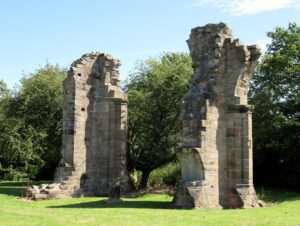
It all starts with Parbold’s first mention in the documents of Burscough Priory and Cockersand Abbey at the turn of the twelfth and thirteenth centuries.
Its ancient origins from small and scattered settlements in wooded areas can still be seen today, on the eastern slopes of the village and around the walking routes, where wooded areas have become popular dog-walking routes.
Mark Dowding a local historian explained how Parbold came about, from its very humble origins. He said: “[Parbold now] is basically a residential village, which is very different to what it used to be. In the original days, it wasn’t even a village as we know.
“There was nothing here really, maybe a few farms, but that was it.”
Human occupation in Parbold after the Norman conquest cannot be proved, however, the consensus is there would have been small settlements in the surrounding areas.
Although there is little solid evidence of early human occupation in the Middle Ages, the name Parbold points to a seventh or eighth-century origin. The name ‘Bold’ or ‘Botl’ comes from the Old English meaning of a dwelling. Parbold has gone through a few name changes over the years: from Iperbolt in 1195, Perebold in 1202, Perbold in 1212, Perbalt in 1292 and finally Parbold. It is said to mean ‘the place where pears grow’.
Parbold first came to be prominent for industry, work and residence in 1774 when the Leeds-Liverpool canal was built through the centre of the village. Before that, the River Douglas was the main waterway for boats travelling between Wigan and Tarleton. Both waterways remain popular landmarks for the village.
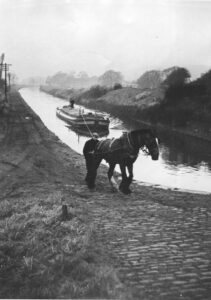
The arrival of the canal in the eighteenth century improved and widened trade routes from the village to international ports like that in Liverpool, this helped Parbold develop its industries in the village from farming produce to milling and quarrying.
Mark Dowding explained the importance of the development of the canal system. He said: “The canal came and it really opened things up because you could take things like coal and stone on barges, which was better than the roads, which were bad.
“The canal gave [Parbold] a good path to places like Wigan, Burscough and Liverpool eventually.”
One of Parbold’s main landmarks is the Mill near the Windmill Pub on Mill Lane, this is a relic of the industrial era in Lancashire and can be dated to 1794. The Mill that stands now dates back to the mid-nineteenth century and can be seen in great condition today serving as a reminder of the village’s milling history dating back to 1288.
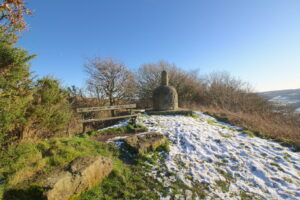
Industry shaped the village and its community from the farming workers in the fields, to the milling and quarrying areas throughout the Douglas Valley in which Parbold is situated. The workforce’s influence on the village can be seen in their construction of what is known colloquially as ‘The Parbold Bottle’, which celebrated the Great Reform Act of 1832. This remains a prominent landmark at the top of Parbold Hill today.
The arrival of the railway in 1855, marked a huge transformation for the village, as the canal did, connecting the inner cities to the port of Liverpool. The railway provided much quicker transport between Southport and Manchester and just so happened to go straight through the middle of Parbold.
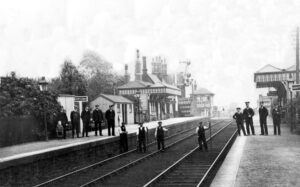
It was at this point in 1855, that Parbold became a place to live for the wealthy business leaders from Liverpool, Manchester and Preston. What attracted them to Parbold can only be speculation, however, if today is anything to go by, Parbold would have provided a quiet residence in the countryside while being central and having good transport links to the surrounding areas.
The arrival of wealthy businessmen created a big divide in the community, this was both figurative as well as physical, which can be seen today. The Mill side of the rail tracks, near the public houses and milling building marked the area where the workers lived in smaller residences. While past Station Road, and towards the Common and Tan House Lane was where the wealthy business leaders built their large houses.
This so-called ‘class-divide’ existed for many years and was clearly seen when the village welcomed child evacuees during World War Two.
While World War Two did not directly affect the village, Parbold played host to evacuees from the surrounding cities who were being bombarded by the Nazi bombing campaigns, while its female resident took up the work while the men went off to fight.
Joan Wilson, a resident of Parbold told local historian Mark Dowding of her experiences during wartime in the village.

She said: “[The children] came from Salford, the slums of Salford and there was a snobbery.
“They were all taken to the Women’s Institute, and the people up Tan House Lane and the people up The Common had the pick… we got the leavings, we got those full of nits and impetigo.”
While the Nazi bombs fell on Liverpool, just nineteen miles away, evacuees from the city were welcomed into the village, however not all were success stories.
Geoff Monk, who was a child in the village at the time, also shared his experiences of such an incident that did not go so well.
He said: “We had the evacuees here; they came out from Liverpool, and they came to live with us as well.
“We had three different families [living with us]. One was only here two or three nights, and I don’t know why but my mother went into the bedroom this particular morning and saw a revolver on the bed, so my father was onto the authorities straight away and they came and took them.”
While Parbold would have been the ideal setting for children evacuated from the city with its countryside lifestyle, one incident reminded the village that the war over Liverpool and Manchester was not that far away.
Audrey Dowding, a resident of Parbold during the war told of the time when a German bomb landed in the village.
She said: “This particular Saturday night, I was asleep in the living room on the settee, and this bomb fell on Cartmel’s field over the other side of the Douglas.
“And it just lifted me high off the settee. It shattered Fitzpatrick’s window next door.
“Obviously, the plane was just dropping this bomb to get rid of it on his way back to Germany.
“There was this huge crater – we went to see it the next morning – huge crater. As far as I know, that was the only bit of excitement we had around here.”
Following the war, Parbold transformed into what can now be identified as a modern village. Shaped by new arrivals from the war-torn cities of Liverpool and Manchester and ‘new town’ like Skelmersdale which is just 5 miles away, the village became home to a new type of resident – the commuter.
The railway remained and still remains to this day a vital transport network to Southport and Manchester and beyond, however its importance to the village shifted from a quicker route for trade, to a vital network for residents to travel to work.
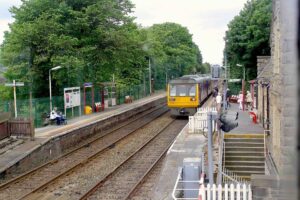
Through all this change the village retained its quiet, countryside feel, while surrounding areas like Skelmersdale saw expanded urbanisation. That is not to say Parbold has not seen a proliferation of houses to reflect the population boom of recent year, but it has not transformed into a different place – and this is probably one reason why Parbold has kept its character.
Nowadays, the canal, the windmill and the fields of Parbold have mostly lost their industrial power, but their purpose has now changed. Their recreational value has meant they have remained in the village bringing in visitors who want to sample the countryside lifestyle.
Traditional pubs like the Wayfarer near the River Douglas and The Windmill near the Canal bridge, have preserved the village’s ‘old’ identity, while modern influences like Margot’s wine bar and Miller and Carter’s steak house on top of Parbold Hill, show the village has moved with the world’s modernisation. This juxtaposition reflects the village perfectly from a hub during the industrial revolution, to a commuter village lying in the middle of two modern-day metropolitan cities.
I have just scratched the surface of this place’s history, a village shaped by historical events and its surrounding areas, also shaped by the people who call it home.



